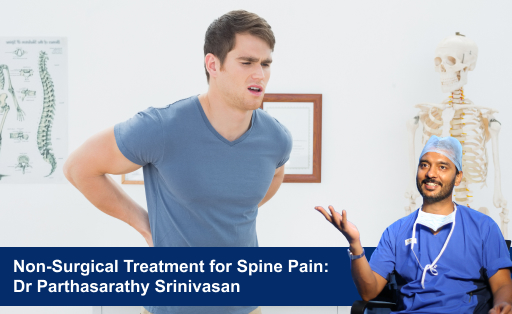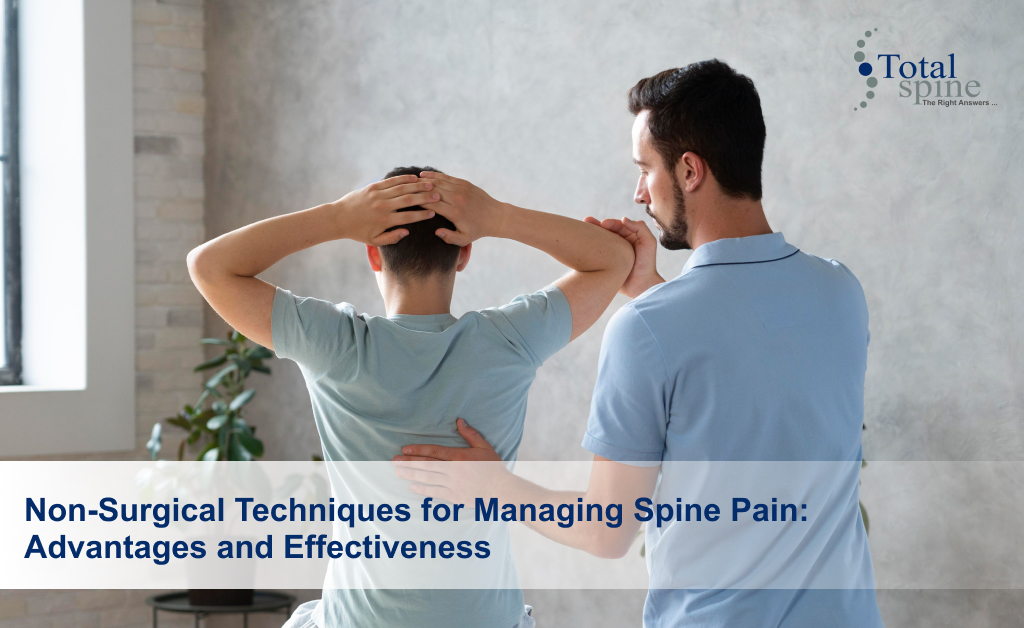Introduction
One’s quality of life can be substantially impacted by back pain since it can make regular tasks difficult and uncomfortable. Exploring non-surgical options for spine pain treatment can offer excellent relief and perhaps prevent the need for invasive procedures, even if surgery may be required in some circumstances. Dr Parthasarathy Srinivasan intends to examine numerous non-surgical treatments for people with back pain in this blog, illuminating their advantages, efficacy, and applicability for diverse circumstances.
Understanding Non-Surgical Spine Pain Management Techniques
Non-surgical options include a variety of therapies and treatments that work to reduce back pain and enhance general function without the need of intrusive procedures. These methods emphasis treating the underlying conditions that are causing the pain, lowering inflammation, accelerating healing, and boosting the body’s inherent capacity to cope with discomfort. People with mild to moderate back pain or those who want to try conservative measures first before considering surgery may benefit most from non-surgical treatments.
Rehabilitation and physical therapy
A key component of non-surgical spine pain care is physical therapy. A licensed physical therapist may create a personalized training plan to increase flexibility, strengthen the muscles that support the spine, and address postural abnormalities. Exercises for strengthening the core, manual treatments like massage, and focused stretching may all be a part of physical therapy. This all-encompassing method seeks to improve spine stability, lessen discomfort, and reinstate optimal function.
Medicines and Injections for Pain
Painkillers are regularly used to provide short-term relief and improve the patient’s ability to treat in physical therapy or other rehabilitative activities in non-surgical spine pain management. While other non-steroidal anti-inflammatory drugs (NSAIDs) can help reduce inflammation and relieve discomfort, muscle relaxants are often used to treat muscular spasms. Rarely, corticosteroid injections can be administered directly into the affected area to reduce swelling and provide targeted pain relief. It’s important to keep in mind that while drugs and injections may momentarily ease back pain, they cannot address its root causes.
Changes in lifestyle and self-care
Self-care habits and specific lifestyle changes can make a big difference in the non-surgical management of spine pain. The tension on the spine can be lessened by maintaining a healthy weight, and poor posture and ergonomics can save the spinal structures from undue pressure. Regular exercise helps strengthen supporting muscles and increase spine flexibility, such as low-impact sports and mild stretching. Adding relaxation exercises to everyday routines, getting enough sleep, and using stress management strategies may all assist with pain management and general well-being.
Various Therapies
Numerous complementary treatments are now well-known for their potential value in treating back pain. These treatments emphasis comprehensive strategies that deal with the psychological as well as the physical components of pain. For instance, in acupuncture, tiny needles are inserted into particular body locations to stimulate the body’s own pain-relieving systems and encourage recovery. Manual adjustments are used in chiropractic treatment to straighten the spine, lessen nerve impingement, and relieve pain. By easing stress, increasing circulation, and fostering relaxation, other complementary therapies including yoga, massage therapy, and herbal medicines can also offer assistance.
Therapy for Spinal Decompression
The goal of spinal decompression therapy is to relieve pressure on the spinal discs and nerves without the need of surgery. The spine must be gently stretched and tractioned, either manually or with the use of specialized machinery. By applying negative pressure to the spinal discs, this treatment encourages ruptured or bulging discs to retract, reducing pressure on the nerves. For people with diseases including ruptured discs, degenerative disc disease, or spinal stenosis, spinal decompression treatment can significantly reduce discomfort.
Techniques for Electrical Stimulation
Electrical stimulation techniques are non-surgical methods for treating back pain that make use of electrical currents. In order to block pain signals and encourage the release of endorphins, transcutaneous electrical nerve stimulation (TENS) entails applying electrodes to the skin close to the painful location. The implantation of a tiny device that sends electrical pulses to the spinal cord and prevents pain signals from reaching the brain is another method known as spinal cord stimulation (SCS). For those who are good candidates, these strategies can successfully control back discomfort and enhance overall performance.
Body-Mind Techniques
Mind-body treatments can be extremely beneficial in the non-surgical treatment of spine pain since they address both the physical and emotional components of pain. People can become more aware of and take charge of how they feel pain by experiencing relaxation and mindfulness exercises. By reducing your stress levels, promoting relaxation, and empowering you, these techniques can help you manage back discomfort. Dr Parthasarathy Srinivasan also suggests cognitive-behavioural therapy (CBT) which can help patients build coping skills, and improve their overall emotional wellness.

Multidisciplinary and Collaborative Approaches to Care
Non-surgical spine pain care frequently entails a team effort and interdisciplinary approach. In order to create a thorough treatment plan that is specifically catered to the needs of the patient, healthcare experts from several specialities, such as orthopaedic surgeons, physical therapists, pain management specialists, and psychiatrists, may collaborate. With this teamwork, all facets of the spine pain are taken care of, from physical rehabilitation to pain management and psychological well-being. Individuals might gain from a more holistic and integrated approach to their spine pain care by integrating the knowledge of several doctors.
Patient Self-Management and Education
A key element of non-surgical spine pain therapy is patient education. People may actively participate in their rehabilitation when they are aware of the underlying reasons of their spine pain, are aware of the available treatments, and have self-management techniques at their disposal. People can avoid future spine-related problems by receiving education on good posture, body mechanics, and ergonomics. Additionally, sharing knowledge about self-care practices, lifestyle changes, and pain management methods empowers people to take control of their back pain and make wise treatment choices.
Long-Term Advantages and Factors
Individuals may have long-term advantages by selecting non-surgical solutions for the treatment of spine pain. These methods not only reduce pain but also work to improve function, treat underlying causes, and promote general well being. Non-surgical therapies are effective for those who may not be good candidates for surgery or prefer conservative methods since they frequently carry less risks and problems than invasive surgical procedures. It is good to remember that the efficacy of non-surgical methods might vary based on the particular illness and individual circumstances. For choosing the right course of therapy, consulting with medical experts is essential.
Individualized Treatment and Aftercare
Since each person’s spine pain is distinct, each person should have a different non-surgical treatment plan to manage it. When developing a treatment plan, healthcare providers will take into account elements including the underlying reason of the pain, the intensity of the symptoms, general health, and personal preferences. To measure progress, make modifications as necessary, and guarantee the continuous efficacy of the selected non-surgical therapies, regular follow-up care and monitoring are crucial. To address any issues, offer support, and adjust the treatment plan as required, there must be open communication between the patient and their medical team.
Conclusion
Investigating non-surgical options for spine pain therapy gives people a variety of efficient choices to reduce pain, boost function, and improve general well-being. These non-invasive techniques, which range from physical therapy and rehabilitation to painkillers, injections, and alternative therapies, provide hopeful outcomes for those with back pain.
To choose the best non-surgical treatment plan based on unique needs and specific spine disorders, it is vital to Contact medical professionals like Dr Parthasarathy Srinivasan, one of the best spine doctors or pain management specialists based in Chennai. People can find relief and restore control of their life without the need for intrusive treatments by adopting these non-surgical options.

